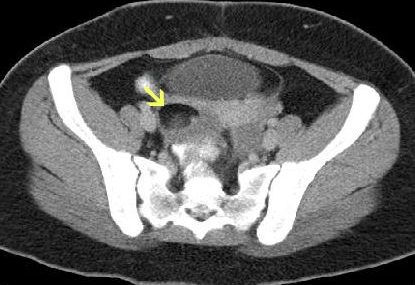Ovarian Teratoma
What is a teratoma ovarian cyst?
Ovarian teratoma (тератома яичника, дермоидная киста, كيس درمويد) is a germ cell tumor that develops in or on the ovary, it is a dermoid cyst tumor that is composed of one or more layers (1-3) of cells that form during embryogenesis.
Are teratoma tumors cancerous?
In most cases, ovarian teratomas are usually benign (mature teratomas), however rarely, ovarian teratomas can be cancerous.
Germ cell tumors can be cancerous (malignant) or non cancerous (benign) neoplasms that originate from gametes. Sex cells come in two types, sperm in men and the ovum or egg (plural = ova) in females.
Where does a teratoma come from?
Ovarian teratomas originate from one or more germ layers and may be monodermal or polydermal. However, in most cases, teratoma germ cells differentiate in ways suggesting other germ layers.
How common is ovarian teratoma?
Ovarian teratoma is the most common histological type of germ cell neoplasms. It represents a histologically diverse group of tumors.
Mature cystic teratomas account for about 20% of all ovarian neoplasms.
What is a serous Cystadenofibroma?
An ovarian cystadenofibroma (CAF) is a rare benign epithelial ovarian tumor in which the fibrous stroma remains a dominant component of the tumor. Ovarian cystadenofibromas account for about 2 % of all benign ovarian tumors.
Serous cystadenocarcinomas are the most common form of ovarian cancer making up 80 percent of malignant ovarian tumors. Papillary serous cystadenocarcinomas originate from the coelomic epithelium.
Serous cystadenocarcinomas account for about 25% of ovarian tumors in women aged over 25
At least 20% of malignant ovarian tumors are nonepithelial cancers. Ovarian germ cell tumors (OGCT) and sex cord-stromal tumors (OSCST) are ovarian tumors of nonepithelial origin, each of which account for less than 5% of all ovarian cancers. Approximately 5-10% of the ovarian cancers are metastatic malignancies originating from distant organs, such as the breast or GI tract.
Malignant teratomas (germ cell tumors) arise from the germ cells of the ovary, they are common in young women (ages 14-25) and are rare in females over the age of 30
Symptoms
What are the symptoms of ovarian teratoma?
In 65% of cases with teratoma, females are usually asymptomatic; however, when symptoms are present, they may include:
- Irregular menses (metrorrhagia) that occurs between the expected menstrual periods. It is characterized by delayed menstruations and prolonged menstrual bleeding (heavy menses).
- Vague, bloating and gas issues in the abdomen.
- Adnexal mass in the abdomen
- Backache and abdominal pain, especially during and before menses.
- Weakness, fainting and anemia are also characteristic in such patients
Complications
What are the symptoms of an ovarian torsion?
Symptoms of ovarian torsion can include severe lower abdominal pain (an acute abdomen) and bleeding
What are the complications of a ruptured ovarian cyst?
Acute abdominal pain in females with ovarian teratoma is a concern and should be checked immediately because it may be a may be a sign of ovarian torsion (adnexal torsion). Prompt diagnosis of ovarian torsion may reduce morbidity. Ovarian torsion is a medical emergency (an acute abdomen), requiring urgent intervention and prompt diagnosis.
Causes
What is the cause of a teratoma?
In most of the cases, benign ovarian neoplasms (tumors of the ovaries) arise from benign functional cysts that are common in young women. However, malignancy occurs due to the presence of embryonal carcinoma cells (germ cell tumor).
Genetic predisposition is often regarded to be the primary cause of ovarian cysts, between 35 and 70 percent of women with a BRCA1 mutation would get ovarian cancer. About 20 percent of women with BRCA2 mutations would get ovarian cancer by age 70
Treatment
What are the treatment options for ovarian teratoma?
- Surgical excision of the tumor or cyst. Laparoscopic ovarian cystectomy is a gold standard procedure in which ovarian cysts are removed, it is ideal for women wishing to preserve their fertility
- Removal of the ovary if multiple tumors are observed. Oophorectomy is a surgical procedure in which one or both of your ovaries are totally removed, it is ideal for women who choose not to have kids in the future
Next steps management
How to diagnose ovarian teratoma?
Ovarian teratoma diagnosis and management:
- Ultrasound of the pelvis and abdomen
- Testing for tumor markers, such as CA-125, alpha fetoprotein, beta-Hcg, LDH to rule out malignancies, however, the risk of ovarian cancer increases with age. As people get older, the risk of developing ovarian tumors increases
References
Verified by: Dr.Diab (November 18, 2017)
Citation: Dr.Diab. (November 18, 2017). Ovarian Teratoma Causes Symptoms and Treatment. Medcoi Journal of Medicine, 8(2). urn:medcoi:article15726.














There are no comments yet
Or use one of these social networks